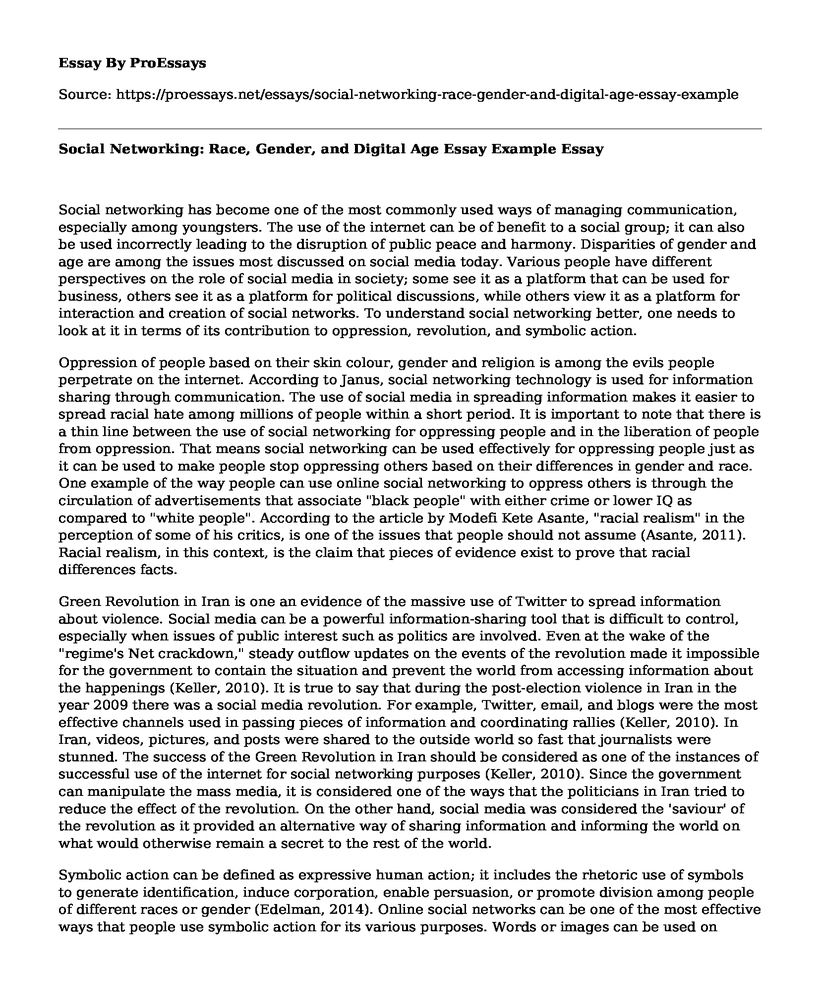Social networking has become one of the most commonly used ways of managing communication, especially among youngsters. The use of the internet can be of benefit to a social group; it can also be used incorrectly leading to the disruption of public peace and harmony. Disparities of gender and age are among the issues most discussed on social media today. Various people have different perspectives on the role of social media in society; some see it as a platform that can be used for business, others see it as a platform for political discussions, while others view it as a platform for interaction and creation of social networks. To understand social networking better, one needs to look at it in terms of its contribution to oppression, revolution, and symbolic action.
Oppression of people based on their skin colour, gender and religion is among the evils people perpetrate on the internet. According to Janus, social networking technology is used for information sharing through communication. The use of social media in spreading information makes it easier to spread racial hate among millions of people within a short period. It is important to note that there is a thin line between the use of social networking for oppressing people and in the liberation of people from oppression. That means social networking can be used effectively for oppressing people just as it can be used to make people stop oppressing others based on their differences in gender and race. One example of the way people can use online social networking to oppress others is through the circulation of advertisements that associate "black people" with either crime or lower IQ as compared to "white people". According to the article by Modefi Kete Asante, "racial realism" in the perception of some of his critics, is one of the issues that people should not assume (Asante, 2011). Racial realism, in this context, is the claim that pieces of evidence exist to prove that racial differences facts.
Green Revolution in Iran is one an evidence of the massive use of Twitter to spread information about violence. Social media can be a powerful information-sharing tool that is difficult to control, especially when issues of public interest such as politics are involved. Even at the wake of the "regime's Net crackdown," steady outflow updates on the events of the revolution made it impossible for the government to contain the situation and prevent the world from accessing information about the happenings (Keller, 2010). It is true to say that during the post-election violence in Iran in the year 2009 there was a social media revolution. For example, Twitter, email, and blogs were the most effective channels used in passing pieces of information and coordinating rallies (Keller, 2010). In Iran, videos, pictures, and posts were shared to the outside world so fast that journalists were stunned. The success of the Green Revolution in Iran should be considered as one of the instances of successful use of the internet for social networking purposes (Keller, 2010). Since the government can manipulate the mass media, it is considered one of the ways that the politicians in Iran tried to reduce the effect of the revolution. On the other hand, social media was considered the 'saviour' of the revolution as it provided an alternative way of sharing information and informing the world on what would otherwise remain a secret to the rest of the world.
Symbolic action can be defined as expressive human action; it includes the rhetoric use of symbols to generate identification, induce corporation, enable persuasion, or promote division among people of different races or gender (Edelman, 2014). Online social networks can be one of the most effective ways that people use symbolic action for its various purposes. Words or images can be used on social media to pass a message. For instance, when people share images of people shot in the streets and of people demonstrating on the streets, it becomes apparent to social media users who access such content that the intention is to spread information about an ongoing, intended or past violence (Asante, 2011). Such content can then be widely shared leading to the massive spread of information about events that people would not know about easily. For example, politicians can use symbolic language to communicate to their followers, organize rallies, and pass critical pieces of information to electorates. Politicians can use symbolic action to enhance peace or perpetrate violence.
Conclusion
In summary, various people use the internet to enhance social networking, especially in situations of political, gender and racial disparities. The fact that the internet has converted the world into a global village makes it easier for people to use platforms such as Facebook, Twitter, and Instagram among others to either promote unity and equality among genders and races or promote gender and race-based prejudice. It is important to note that politicians can either use symbolic action through social media to either bring unity among people or lead to division.
References
Asante, M. (2011). Race, Intelligence and the Limits of Science: Reflections on the Moral Absurdity of "Racial Realism". Retrieved from http://www.timwise.org/2011/08/race-intelligence-and-the-limits-of-science-reflections-on-the-moral-absurdity-of-racial-realism/
Asante, M. (2011). Racism, Violence and the Irony of Stereotypes. Retrieved from http://www.timwise.org/2011/08/racism-violence-and-the-irony-of-stereotypes/
Edelman, M. (2014). Politics as Symbolic Action. Saint Louis: Elsevier Science.
Keller, J. (2010). Evaluating Iran's Twitter Revolution. Retrieved from https://www.theatlantic.com/technology/archive/2010/06/evaluating-irans-twitter-revolution/58337/
Cite this page
Social Networking: Race, Gender, and Digital Age Essay Example. (2022, Oct 23). Retrieved from https://proessays.net/essays/social-networking-race-gender-and-digital-age-essay-example
If you are the original author of this essay and no longer wish to have it published on the ProEssays website, please click below to request its removal:







